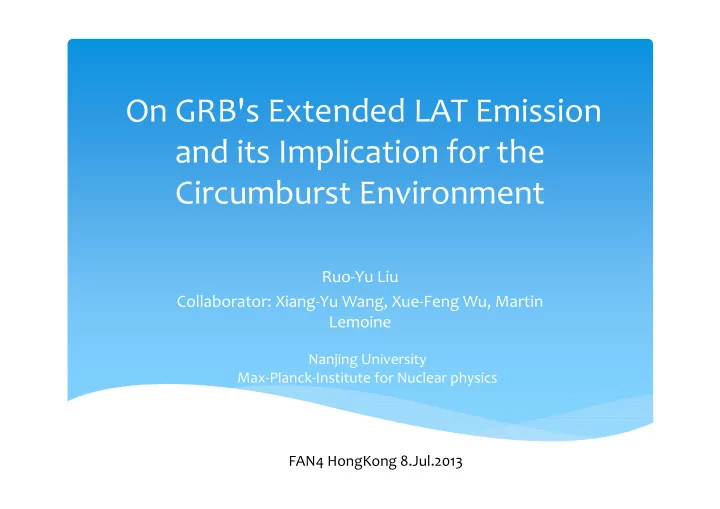

On GRB's Extended LAT Emission and its Implication for the Circumburst Environment Ruo ‐ Yu Liu Collaborator: Xiang ‐ Yu Wang, Xue ‐ Feng Wu, Martin Lemoine Nanjing University Max ‐ Planck ‐ Institute for Nuclear physics FAN4 HongKong 8.Jul.2013
Progenitor of GRB Long GRB (T 90 >2s) Type II (Long soft GRB?) collapse of massive stars (e.g. Wolf ‐ Rayet star) galaxy disk (“high”/moderate density ambient medium) Short GRB (T 90 <2s) Type I GRB (Short hard GRB?) mergers (NS ‐ NS, BH ‐ NS) galaxy halo (low density ambient medium) The circumburst environment can shed some light on GRB’s origin
GRB afterglow Fireball model of Afterglow (Meszaros&Rees 1994 ,Sari&Piran 1995, Sari et al. 1998, Dai&Lu 1998) � ��� , � �, � � , �, ��, � � , � � � Modeling multiband afterglow can give some information of circumburst environment
Kumar&Barniol ‐ Duran 2009a GRB 080916C Cenko et al. 2011 A two component jet model for GRB 090902B (Liu & Wang 2011) Kumar&Barniol ‐ Duran 2009b
Multiband radiation of GRB afterglow High Energy (>100MeV) ,X ‐ ray, Optical, Radio Universal synchrotron spectrum from forward shock X ‐ ray 10keV Radio Gamma ray Optical >100MeV Radio , ' a m c c
synchrotron spectrum X ‐ ray (p=2.2) 10keV Radio Gamma ray Optical >100MeV Radio , ' a m c c with (Liu et al. 2013)
Synchrotron Self ‐ Compton component in High energy Afterglow (Dermer et al 2000, Zhang & Meszaros 2001, Zou et al. 2009, Wang et al. 2013, Fan et al .2013 and etc) Emax of synchrotron radiation is limited Synchrotron radiation can hardly produce >10 GeV (constrained by synchrotron cooling) photons after a few hundred seconds Synchrotron radiation can hardly produce >100 MeV photons after ~1000s (In the decaying micro ‐ turbulence magnetic field scenario) See Prof. Wang talk
Lightcurve of extended high energy emission (2 3 )/4 1.15 p Syn component F T T (p=2.2) in both ISM case and wind case If E max ‐ > E ob , an exponential ‐ like cutoff will occur (11 9 )/8 p 1.1 (p=2.2) in ISM case F T T SSC component 2.2 p F T T (p=2.2) in wind case
(In the decaying micro ‐ turbulence magnetic field scenario) Wang, Liu & Lemoine 2013
(In the decaying micro ‐ turbulence magnetic field scenario) Wang, Liu & Lemoine 2013
Synchrotron cooling ‐ constrained E max GRB 130427A Liu, Wang & Wu 2013
Conclusion Considering the KN effect in X ‐ ray afterglow modeling enhances the obtained circumburst density The enhanced circumburst density potentially promises a SSC component from forward shock The extended high energy emissions (especially the >10 GeV photons) likely have a SSC origin Whether the SSC component shows up, and (if present) its temporal behavior can help us diagnose the circumburst environment. The presence of a SSC component in LAT ‐ detected GRB implies the density of circumburst environment is not low as indicated in previous studies. Thanks for you attention
Recommend
More recommend